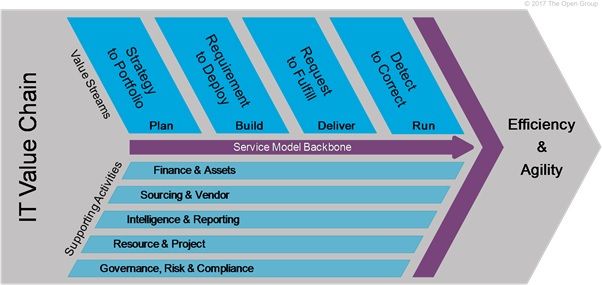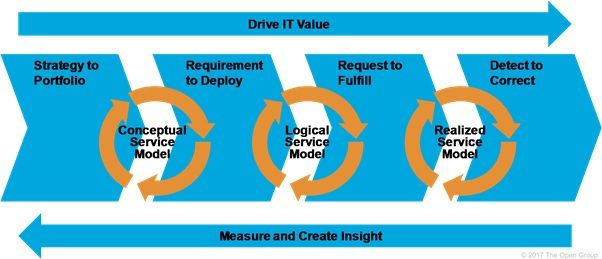For many companies, the IT service pipeline is broken. Siloed technologies, multiple data and architecture models across vendors, and complex integrations prevent organizations from understanding end-to-end IT workflows. Previous standards and practices within the ITSM space, like ITIL® and COBIT, have described how to manage your people, processes, and technologies to address IT management gaps. These standards offer process-level ITSM standards, but they lack prescriptive guidelines on managing service models and IT service lifecycle.
Compared to other ITSM frameworks, IT4IT is a relative newcomer. Importantly, IT4IT doesn’t replace the framework that’s already working for you—it’s meant to complement that framework. Think of IT4IT as the missing piece in your ITSM puzzle. In this introduction, we will:
- Look at why IT4IT was developed
- Explore its four value streams
- Include additional resources for continued IT4IT learning
IT4IT explained
The Open Group, the same organization that developed TOGAF, debuted its IT4IT Reference Architecture in 2015. ITSM reference architectures are nothing new but the Open Group built IT4IT to focus on the entire range of data, functions, and tools necessary in ITSM, including IT asset management (ITAM) and IT operations management (ITOM). Like other frameworks, IT4IT is vendor agnostic and it supports agile, lean, and DevOps methodologies. A common myth is that IT4IT replaces your framework, which is false; IT4IT is meant to augment them.
IT4IT was designed as a solution to problems many enterprises have with slow, error-prone manual activities related to linking functions. Code management, release management, packaging, deployment, and configurations are common issues. The answer that IT4IT proposes: a single architectural framework across the value chain. This value chain helps manage the business of IT throughout the IT service lifecycle. The outcome of IT for IT is to align and adapt the business and IT models without compromising compliance and cost controls.

Source: Opengroup.org
Benefits of the IT4IT reference architecture
IT4IT sees IT as a production-organized business, which considers the business demands first, and then develops appropriate solutions. The value-chain concept is a tried and tested methodology that’s based on your business—it can be measured and it works. Benefits of this value chain approach include:
- Lower ITSM costs
- Increased production efficiencies
- Simplified workflows
- End-to-end traceability
Importantly, IT4IT can be implemented incrementally, so you can run your business and improve it.
The IT4IT value chain
The value chain is the heart of the IT4IT reference architecture. An IT value chain may involve all activities and technologies that produce valuable products or services for business users. The framework defines the primary and supporting activities critical to the IT service lifecycle:
- Primary activities are those related to delivering specific IT-driven business functions.
- Supporting activities are tasks meant to improve the efficiency of the primary activities.
The framework provides guiding principles on managing functional components and data objects within the IT service lifecycle. Instead of improving IT processes, IT4IT key elements of the underlying supporting framework are evaluated based on the value streams. The common tooling and capabilities necessary to leverage the functional components and data objects are defined. These value streams are:
- Strategy to Portfolio (S2P), the planning phase
- Requirement to Deploy (R2D), the building phase
- Request to Fulfill (R2F), the delivery phase
- Detect to Correct (D2C), the run phase
Strategy to Portfolio (S2P)
The S2P value stream focuses on aligning IT portfolio management with business innovation. So first, you must plan. This service approach looks across interconnected IT functions to establish a holistic view of the IT portfolio, so that IT decisions align with business goals. The business demands for service selection is considered to establish an IT portfolio that’s driven by business values.
Typical activities include:
- Defining business objectives for a service
- Setting up policies and standards, based on business value, risks, and benefits
- Aligning IT roadmaps with long-term business goals
- Rationalizing the service portfolio
- Building a service blueprint
- Analyzing demands based on priority and impact
Aligning the IT portfolio with business requirements results in strong visibility into the IT service portfolio. Strong collaboration and communication by key stakeholders in IT departments and business departments across the organization is key to successful S2P execution.
Requirement to Deploy (R2D)
The next phase focuses on building services to be available for users. To start, the business units should create a concept of the service, which IT can then translate into logical service requirements.
Typical activities in the R2D phase include:
- Designing IT services, including standard procedures and policies, and selecting functional and testing requirements
- Developing the services, including version control, establishing IT environments for your SDLC framework, testing and QA
- Sourcing, testing, and delivering services into the next value stream per your strategy release schedule
At the end of this phase, all developed services should comply with organizational standards and policies. The result? Predictable outcomes, enhanced performance and availability, and accelerated service delivery throughout the SDLC pipeline. A focus on automation and collaboration remains the key criteria for successful R2D execution.
Request to Fulfill (R2F)
In this third value stream, the service is delivered to the end users. Developing guidelines is key to streamlining end-user service consumption, without requiring assistance from IT.
Delivery activities in the R2F phase include:
- Designing and publishing pricing options and SLA terms
- Establishing service access
- Deploying self-service options, personalized experiences, and subscription management options
- Automating deployment as new features are released to the service
- Measuring service performance and user feedback
With this link in the value chain, your company can innovate quicker and deliver new feature improvements, resulting in end-user satisfaction and speedy realization of business value.
Detect to Correct (D2C)
The final value stream, D2C seeks to maintain the dependability and improvement of continuous service. Common activities in this phase include:
- Troubleshooting, monitoring, and measuring IT incidents events
- Diagnosing potential performance issues
- Automating resolutions to common issues
- Analyzing change requests relative to risk, value, and end-user experience
By aligning IT services with business goals and end-user satisfaction, you are promoting effective change management and improving your issue resolution deftly and quickly.
Ready for your framework to do more for ITSM? IT4IT is the next step you need for value-driven business results.
Limitations of IT4IT
No standard is perfect, and that is true for IT4IT. While the framework is comprehensive, it isn’t a good fit for every organization or IT environment. As you consider your options, keep these IT for IT limitations in mind:
- Complex implementation: The framework’s strength is its depth and breadth, but those strengths are challenging for IT organizations that are less mature. You need expertise, resources, and time to implement IT4IT.
- Limited support: Because fewer organizations have adopted the framework, finding skilled professionals and peers to benchmark against can be difficult.
- Little guidance: IT4IT is a reference model, not a detailed how-to guide. You will need to interpret the standard and adapt it to your needs, which can introduce problems.
- May require customized integration: Existing IT tools and data models may need to be customized or replaced, which adds expense and introduces disruption.
- Potential for redundancy: IT4IT doesn’t replace other frameworks. You may find overlap with ITIL®, COBIT, and TOGAF. If the roles of each framework and process are not spelled out, it can result in confusion.








